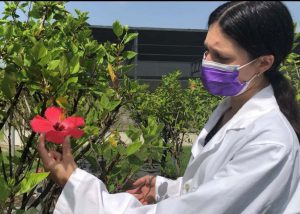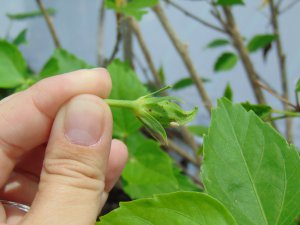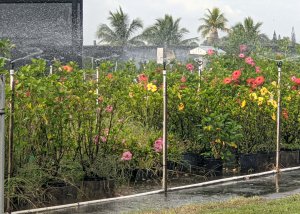- Hibiscus shrubs are attractive and hardy-flowering, typically used in a variety of landscapes. They are known for reaching up to 15 feet tall and 4 to 8 feet wide.
- Many hibiscus species are native to Florida, producing oversized flowers with tissue-thin, ruffled petals from buds that bloom in shades of pink, red, magenta and white.
- While garden pests and fungal disease can disturb the appearance of the shrub, leaving holes in the foliage, University of Florida scientists are aggressively studying ways to stop the spread of the hibiscus bud weevil, a pest they deem very serious.
 HOMESTEAD, Fla –About 35 species of native hibiscus in the United States offer residential, business and public landscapes an abundance of flowers. Those flowers offer many shades — from white to pink to yellow to red. They also attract hummingbirds, butterflies and dragonflies.
HOMESTEAD, Fla –About 35 species of native hibiscus in the United States offer residential, business and public landscapes an abundance of flowers. Those flowers offer many shades — from white to pink to yellow to red. They also attract hummingbirds, butterflies and dragonflies.
A pest known as the hibiscus bud weevil is infesting tropical hibiscus cultivars. These are not Florida native hibiscus species. Growers and the Florida Department of Agriculture and Consumers Sciences – Division of Plant Industry (FDACS-DPI) have isolated the pest in nurseries and are working to prevent the spread of the pest in other areas that include residential landscapes.
Scientists at the University of Florida Institute of Food and Agricultural Sciences (UF/IFAS) are researching the biology of the bud weevil and developing management strategies for nursery growers.

While scientists at the UF/IFAS Tropical Research and Education Center continue collecting data, they have good news for residential landscapes and nurseries. The most recent fact sheet published on Ask IFAS provides nursery owners, homeowners and gardeners with highlights on how to identify the pest, which hibiscus varieties appeared to be most vulnerable and resistant to the pest and what to do if you encounter the hibiscus bud weevil in your landscape.
“We have observed that in south Florida nurseries, pink and yellow hibiscus varieties appear to be more susceptible to this hibiscus bud weevil than red and other varieties,” said Alexandra Revynthi, an assistant professor of entomology and nematology at UF/IFAS TREC. “The pink variety, commonly known as the ‘Painted Lady,’ and the yellow variety, ‘Sunny Yellow,’ are reported to be more susceptible, while the red variety or the ‘President Red’ is reported to be more resistant to the pest.”

Adult weevils feed on buds, stems and to a lesser extent, on leaves of the hibiscus. The females lay eggs in flower buds, and larvae develop inside the bud, causing the bud to drop prior to flowering. Symptoms include holes in stems and unopened buds and cause the bud to drop in high pest densities. There are no visible signs if feeding damage occurs on the leaves, said Revynthi.
“We also know that the pest is isolated to Miami Dade County and the problem seems to perpetuate in the nursery where it can establish and reproduce,” said Revynthi.
Meanwhile, no samples have been collected by UF/IFAS Extension county offices from parks, residential or business landscapes, she said.
“This is good news for consumers and nurseries because it means the pest is isolated and it ultimately keeps it restricted reducing the potential for spread,” she said.
Consumers can do their part by scouting the shrubs. Simply checking for the pest and symptoms, and reporting them to your local county Extension office, will help control the spread in your landscape and others while helping scientists determine any changes in the movement of the pest.
Florida leads hibiscus production nationally, and most nursery production occurs in south Florida. About 20 to 25% of plants sold from Miami-Dade County are hibiscus, where the market value of ornamental plants was $697 million (farmgate price) in 2017, according to the U.S. Department of Agriculture.
The hibiscus bud weevil is a regulated pest by FDACS-DPI. Nurseries found with this pest are required to sign and follow a compliance agreement with FDACS-DPI to reduce the chance of its spread.
Currently, scientists have learned that a combination of integrated pest management methods that include crop rotation with non-host hibiscus plants can help break the population cycle. Active scouting for the pest and systemic removal of dropped buds from the ground have been successful. There are no insecticides specifically registered for this pest, but there are insecticides that can be used against it, said Revynthi.
Studies on entomopathogenic fungi, also known as a fungus that can act as a parasite of insects and kills or seriously disables them, and nematodes as biological control agents are underway at UF/IFAS TREC, said Revynthi.
-30-
By Lourdes Mederos, rodriguezl@ufl.edu
The mission of the University of Florida Institute of Food and Agricultural Sciences (UF/IFAS) is to develop knowledge relevant to agricultural, human and natural resources and to make that knowledge available to sustain and enhance the quality of human life. With more than a dozen research facilities, 67 county Extension offices, and award-winning students and faculty in the UF College of Agricultural and Life Sciences, UF/IFAS brings science-based solutions to the state’s agricultural and natural resources industries, and all Florida residents.
ifas.ufl.edu | @UF_IFAS
 1
1

Comments are closed.